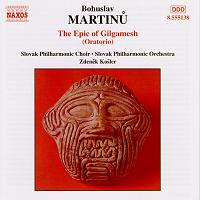
Imagination and strength
The Gilgamesh epic -
recounted by ROBERT ANDERSON'... Zdenek Kosler admirably explores the depth of meaning Martinu revealed in the ancient tale ...'
|

|
The fullest version of the Gilgamesh epic comes from the library of the
Assyrian king Ashurbanipal (669-630), though its origins can be traced to
the third millennium BC. The cuneiform tablets were discovered in 1853,
making a sensational impact when it was realised in 1872 that one section
contained an account of the flood. Part of the story was missing, and the
Daily Telegraph put up a thousand guineas for further excavation.
The newspaper's gamble paid off, and the 'flood' account remains the most
complete section of the epic. Martinu, though, confines himself to the human
interest of the tale, concentrating on the friendship between Gilgamesh
and Enkidu, two mighty figures, who share adventures but come up against
the wrath of gods so that Enkidu must die. It is through the loss of his
friend that Gilgamesh must face the inevitability of death. Martinu makes
selective use of half the twelve tablets recovered from Nineveh. The oratorio
was written in 1955, when Martinu enjoyed the leisure afforded by a Guggenheim
scholarship to spend a couple of years in Nice.
Continue >>
Copyright © 11 August 2002
Robert Anderson, London, UK

|

